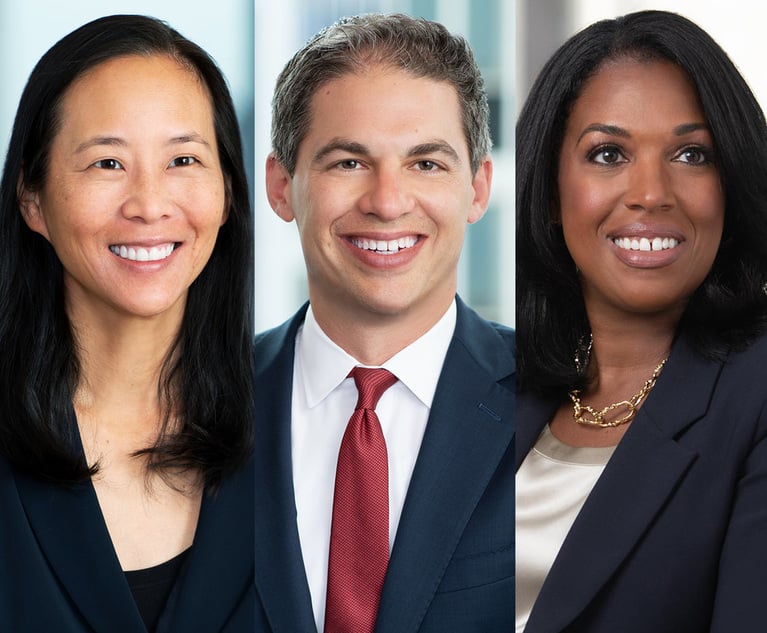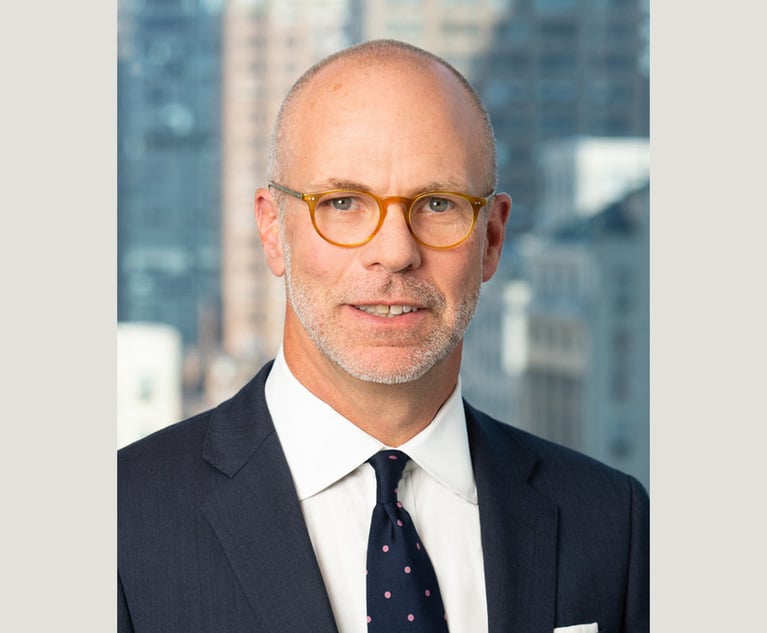Straight to the Top: The Super Rich Drove Nearly All the Am Law 100's Profits Growth
These are the 30 firms that exceeded our benchmarks to make it onto this year's Super Rich list. This year, as much as ever, their ability to build on their wealth stands out among the Am Law 100.
April 21, 2020 at 09:40 AM
6 minute read
The original version of this story was published on The American Lawyer
 Credit: Kevin Fales
Credit: Kevin Fales
Revenue per lawyer and profits per partner don't define a law firm, even if they are useful metrics for measuring financial performance. The COVID-19 outbreak has shown us that firms can be a compass for navigating disaster, a sturdy guidepost when it comes to appropriate business behavior during a crisis and even a model for charitable giving during times of duress.
When it comes to the latter, the firms on this list may be in the best position to help. Since 2014, The American Lawyer has released a list of Super Rich law firms—our attempt to identify those that managed to excel at delivering both revenue and profits. The criteria this year, unchanged from last year, were a revenue per lawyer mark north of $1.1 million and a profits per lawyer payout over $500,000. Also unchanged this year are most of the names on the list.
Money begets money, and these firms are proof. In all, 30 firms qualified for the list this year, one fewer than qualified in 2018. Only two of the 20 firms that made the list when it was first published in 2014—Cadwalader, Wickersham & Taft and Cleary Gottlieb Steen & Hamilton—are not on the 2019 list.
New to this year's list is California-based Fenwick & West, which just missed the cutoff in 2018 due to a PPL short of $500,000. The firm saw a 13% increase in that metric in 2019, moving its PPL from $449,000 to $516,500. Welcome aboard.
Two firms dropped off the 2019 list. King & Spalding, which was at the tail end last year, saw its RPL drop to $1.149 million, a 1.5% decline, while its PPL dropped 4.3% to $489,000, putting it below the threshold. The other firm to vanish from the list was Williams & Connolly, which also fell out of the Am Law 100 this year.
Infographic design by Roberto Jiménez/ALM
Super Rich Versus the Rest
As for the firms that made the list, there are consistencies between 2019 and years past.
Wachtell, Lipton, Rosen & Katz, for example, once again more than doubled the next closest firm (Sullivan & Cromwell) in PPL, posting a $2 million mark compared with Sullivan & Cromwell's $943,000. Wachtell didn't quite keep that same pace on RPL but still managed to outrun second place Sullivan & Cromwell, $3.3 million to $1.8 million.
When comparing the Super Rich to the rest of the AmLaw 100, one can see just how much of the overall growth in the legal industry is associated with this small number of elite firms.
Super Rich firms saw growth of almost 6% in revenue in 2019, while the other 70 firms in the Am Law 100 saw about one-third of that—2.1%.
The contrast between the two in revenue per lawyer is even more stark. The Super Rich grew at 3.1% year over year, while everyone else managed only 0.4%, or roughly one-eighth the growth rate.
Profits per lawyer for the Super Rich saw an increase of 4% to roughly $739,000, while the rest of the Am Law 100 saw only 1.15% growth to $291,243.
Finally, a comparison of profits per equity partner illustrates the difference in payout power between the top firms and others. While both the Super Rich and the rest of the field had a 1:5 ratio of PPL to PEP, the Super Rich saw their PEP grow at 5.1% in 2019, compared with 0.02% for everyone else. From one vantage point, then, all the growth in partner profits among the Am Law 100 in 2019 was facilitated by these 30 firms.
The Path to Profits
Deborah Farone, a legal industry consultant and former chief marketing officer at both Cravath, Swaine & Moore and Debevoise & Plimpton, says much of what she sees in the Super Rich list could be boiled down into three themes that all of the firms seem to have in common, particularly the top 10.
"First, these are firms that do a few things very well," Farone says. "They are not seen as commodity type services."
This allows the firms to enlist clients that might not be so price sensitive, she says. Their expertise also makes the firms more difficult to replace, ensuring a continued revenue stream year over year.
Jim Cotterman, principal with legal consulting firm Altman Weil, agrees.
"These are firms that have staked out very well-defined missions," Cotterman says. "They work more on bet-the-company stuff than the routine run-the-company stuff—bespoke work."
The second element Farone identifies is the bench depth at the top firms.
"When you look at Wachtell or Kirkland, you can see they have a long list of established partners," Farone says.
Cotterman says this is what allows these firms to maintain their place on the list year after year, avoiding pitfalls that can hamper other firms, such as the retirement of senior partners.
While most larger firms maintain strong control over budgets, have a strategic plan in place and leverage other time-keepers to their fullest, the difference between the Super Rich and the rest lies in the ability of the Super Rich to roll out a long list of high-revenue-generating partners even if other elements go sour.
"They keep their people busy with work and can charge a lot for it," Cotterman says.
The final element that Farone outlines is the presence of institutional clients, something she says is a long-term play for firms that, by focusing on the first two elements, can be achieved over time.
"It takes time to build a reputation," Farone says of attracting large, long-term clients that can be the tipping point for a firm financially. "You can't hire a branding person to do it for you. It is more than the color of your logo."
While the next several months will be an unprecedented test for all law firms, the Super Rich are in a strong position to continue to excel. And for the rest of the Am Law 100, Farone says, "It's good to take lessons from how these firms have done so well."
Email: [email protected]
This content has been archived. It is available through our partners, LexisNexis® and Bloomberg Law.
To view this content, please continue to their sites.
Not a Lexis Subscriber?
Subscribe Now
Not a Bloomberg Law Subscriber?
Subscribe Now
NOT FOR REPRINT
© 2025 ALM Global, LLC, All Rights Reserved. Request academic re-use from www.copyright.com. All other uses, submit a request to [email protected]. For more information visit Asset & Logo Licensing.
You Might Like
View All

Big Company Insiders See Tech-Related Disputes Teed Up for 2025

Signaling Growth Goals, Some Law Firms Promote Record Partner Classes
Law Firms Mentioned
Trending Stories
Who Got The Work
Michael G. Bongiorno, Andrew Scott Dulberg and Elizabeth E. Driscoll from Wilmer Cutler Pickering Hale and Dorr have stepped in to represent Symbotic Inc., an A.I.-enabled technology platform that focuses on increasing supply chain efficiency, and other defendants in a pending shareholder derivative lawsuit. The case, filed Oct. 2 in Massachusetts District Court by the Brown Law Firm on behalf of Stephen Austen, accuses certain officers and directors of misleading investors in regard to Symbotic's potential for margin growth by failing to disclose that the company was not equipped to timely deploy its systems or manage expenses through project delays. The case, assigned to U.S. District Judge Nathaniel M. Gorton, is 1:24-cv-12522, Austen v. Cohen et al.
Who Got The Work
Edmund Polubinski and Marie Killmond of Davis Polk & Wardwell have entered appearances for data platform software development company MongoDB and other defendants in a pending shareholder derivative lawsuit. The action, filed Oct. 7 in New York Southern District Court by the Brown Law Firm, accuses the company's directors and/or officers of falsely expressing confidence in the company’s restructuring of its sales incentive plan and downplaying the severity of decreases in its upfront commitments. The case is 1:24-cv-07594, Roy v. Ittycheria et al.
Who Got The Work
Amy O. Bruchs and Kurt F. Ellison of Michael Best & Friedrich have entered appearances for Epic Systems Corp. in a pending employment discrimination lawsuit. The suit was filed Sept. 7 in Wisconsin Western District Court by Levine Eisberner LLC and Siri & Glimstad on behalf of a project manager who claims that he was wrongfully terminated after applying for a religious exemption to the defendant's COVID-19 vaccine mandate. The case, assigned to U.S. Magistrate Judge Anita Marie Boor, is 3:24-cv-00630, Secker, Nathan v. Epic Systems Corporation.
Who Got The Work
David X. Sullivan, Thomas J. Finn and Gregory A. Hall from McCarter & English have entered appearances for Sunrun Installation Services in a pending civil rights lawsuit. The complaint was filed Sept. 4 in Connecticut District Court by attorney Robert M. Berke on behalf of former employee George Edward Steins, who was arrested and charged with employing an unregistered home improvement salesperson. The complaint alleges that had Sunrun informed the Connecticut Department of Consumer Protection that the plaintiff's employment had ended in 2017 and that he no longer held Sunrun's home improvement contractor license, he would not have been hit with charges, which were dismissed in May 2024. The case, assigned to U.S. District Judge Jeffrey A. Meyer, is 3:24-cv-01423, Steins v. Sunrun, Inc. et al.
Who Got The Work
Greenberg Traurig shareholder Joshua L. Raskin has entered an appearance for boohoo.com UK Ltd. in a pending patent infringement lawsuit. The suit, filed Sept. 3 in Texas Eastern District Court by Rozier Hardt McDonough on behalf of Alto Dynamics, asserts five patents related to an online shopping platform. The case, assigned to U.S. District Judge Rodney Gilstrap, is 2:24-cv-00719, Alto Dynamics, LLC v. boohoo.com UK Limited.
Featured Firms
Law Offices of Gary Martin Hays & Associates, P.C.
(470) 294-1674
Law Offices of Mark E. Salomone
(857) 444-6468
Smith & Hassler
(713) 739-1250








